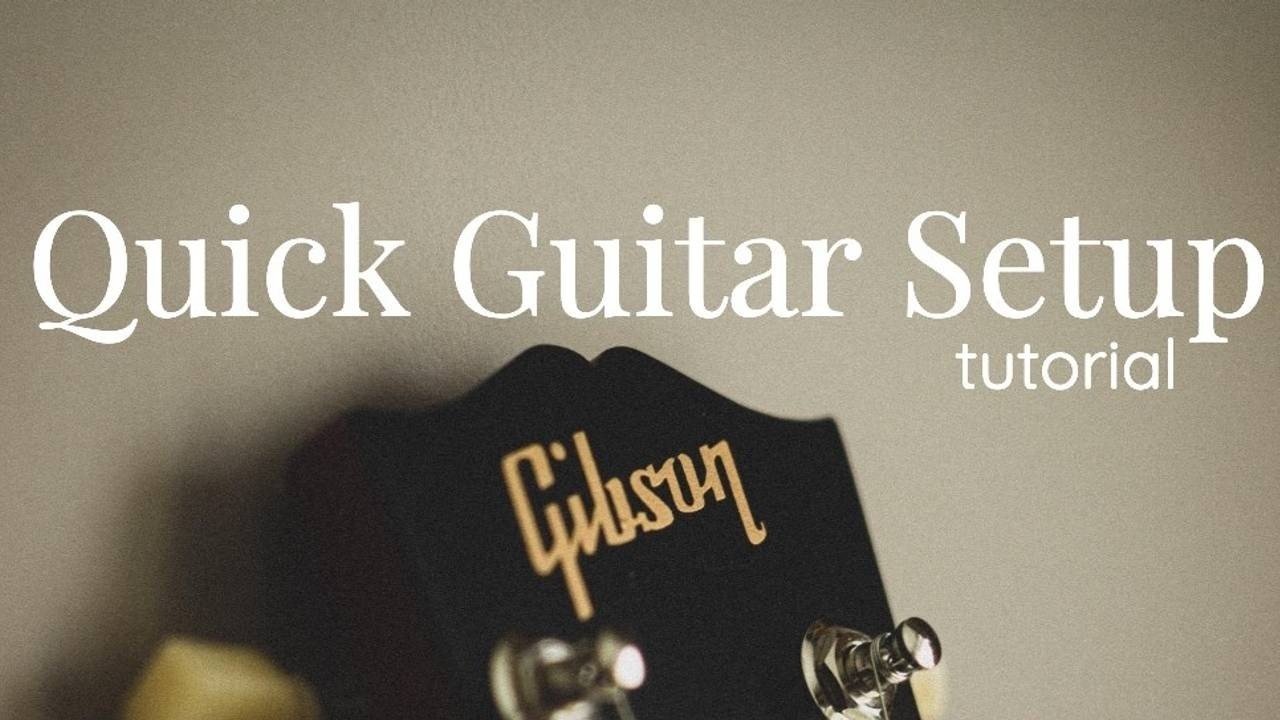
Quick Guitar Setup Tutorial
Jan 06, 2021Tips and Tricks Every Guitar Player Should Know
A guest post by Steve Blundon
Guitars are amazingly durable instruments - but they need a little help once in a while to function properly.
Here are the steps we will got through to set up your guitar.
- Removing the Strings
- Basic Cleaning
- Installing New Strings
- Adjusting Action
- Final Touches
Whether you play jazz, metal, classical, virtually any style, your guitar will suffer the stresses of string pressure and, because it’s being manipulated by a guitar player, succumb to the normal effects of wear and tear.
This means the gear will need some form of maintenance and even the occasional setup.
You can have a reliable individual do this for you, for a price of course, or you can do it yourself. Personally, I’ve found players fall into basically two categories: those who have no problem spending the money to have the work done for them, and those who are hands-on preferring to do the work themselves.
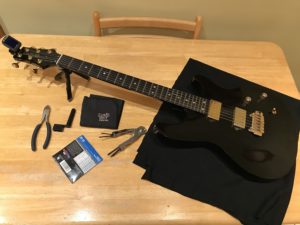
Regardless of which category you identify with, the following tips and tricks will help you save your most valuable resource - your time.
A Few Tools
Since we’re not servicing jet engines, the tools we need are fairly humble. Here’s a short list:
- Side Cutters
- String Winder
- Large and Small Philips Screwdrivers
- Large and Small Flat Screwdrivers
- An Assortment of Allen Keys
- Small Adjustable Wrench
- Cloths or Paper Towels
- Guitar Polish and Cleaner
There are many more depending on how deep you dive, but these should handle the basics.
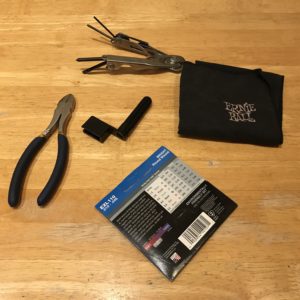
Your instrument may also have come with the required wrenches or adjusters necessary for performing basic maintenance. It’s great practice to keep them in the guitar’s case for easy access when you need them.
Removing Strings
There’s an “old wives tale” that you should never take all the strings off the guitar at one time. This is totally false.
While it is smart to leave a single on to help keep loose parts from falling off, taking all the strings off is actually beneficial to the guitar’s health as it releases built-up compression. The instrument gets a chance to relax and re-normalize.
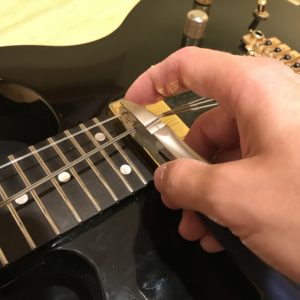
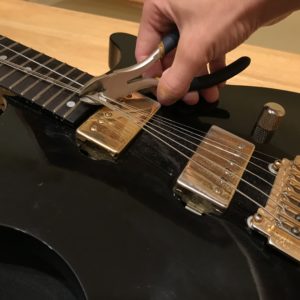
When it comes to working with strings in any quantity, remember to batch your processes!! The work will go faster, it will reduce frustration, and allow you more time to play.
To get started, grab your trusty string winder and, going around the headstock, slacken each string off in turn.
Gather up all the now loosened strings with one hand and cut all the strings in one shot about six inches from the bridge with the side cutters - not the kitchen scissors. You can now freely remove each string from its tuner post, then bundle them all up, and chuck them in the trash. Same goes for the tag ends at the bridge.
Tip: If you’re concerned about guitar parts flying about when you cut the strings, leave one string on as mentioned, or use some rubber bands or low-tack masking tape around the parts to keep them in place.
Basic Cleaning
Most instruments will require a little housekeeping. With the strings removed, this is a great time to go over the guitar and remove junk without interference.

The body and headstock should get a good going over with an appropriate guitar-safe cleaner applied to a soft cloth or paper towel. Personally, I prefer to use a high quality paper towels. They won’t scratch and the dirt goes straight in the garbage without contaminating the rest of the instrument.
As for the fretboard, whether raw wood or finished, a good quality guitar cleaner should lift the surface junk. You can either put a few drops on a cloth or lightly sprinkle the fretboard then rub the fretboard clean.
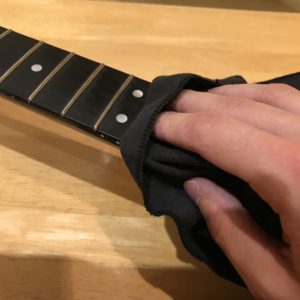
If you wish to tackle the frets and give them a bit more sparkle, good old newspaper will do the trick. As it is slightly abrasive, but please be careful to exercise caution with any abrasive around an instrument. You might want to mask off areas where the neck meets the body just to make sure. Then finish up with a final fretboard cleaning.
Please note, this approach is very basic. Deep fretboard cleaning and fret polishing is a highly detailed process that uses much finer techniques and specific materials. When in doubt, consult a pro or do more research on the task.

While the strings are off, it’s also good practice to go around the headstock and, using the adjustable wrench (or a common 10mm wrench), make sure threaded tuner bushings are snugged up. The same goes for tuner button (machine head) screws. Be careful as these are small parts which don’t like to be over-tightened.
Installing New Strings
Just like removing the old strings - remember to batch your processes!
Install the ball end of each string, one by one, at the bridge in their respective seats. Then move to the headstock and, working from the nut outwards, attach each string in turn to its corresponding tuner post. Allow about an inch and a half of string to accommodate three wraps around each post. Any more than that can cause tuning issues, any less will cause string slippage.
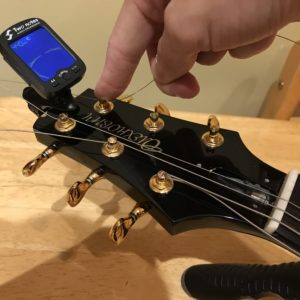
Don’t bother torquing up the strings to full pitch just yet - it’ll be wasted effort. Just get them in the ballpark.
Next, give each string a real light stretch - they’ll drop in pitch a fair bit. Go around the headstock again and bring them up close to pitch. Just get them in the ballpark, you still don’t have to be precise just yet.
Adjusting Action
There are essentially three points to good action: the nut, the bridge, and neck relief.
The nut, being a fixed point should only be adjusted or recut by someone who knows what they’re doing. So let’s assume it’s close enough to work with.
The bridge assembly on electric guitars can be adjusted up or down depending on your preference in overall string height. With acoustic instruments, the saddle determines overall string height. It can be shimmed to increase height, or the bottom can be sanded down to reduce height. Again, if you’re not comfortable with this kind of work, take your guitar to someone who knows what they’re doing.
Neck relief works closely with the bridge, and to a lesser extent the nut. When relief is set properly with the other two points being adjusted properly, all three elements work in harmony much like a perfect triangle.
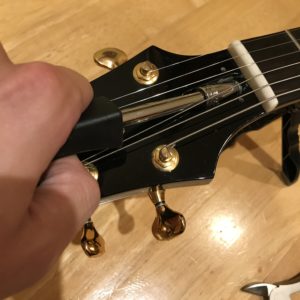
In short, you can easily assess relief using any one of the stings on the guitar. The third string makes a great gauge as it’s close to the centreline of the fretboard, and it’s thin enough to make relative measurements.
Press the string down at the second fret with one hand, and the fourteenth fret with the other hand. These two points eliminate any mis-reads you may get from the extreme ends of the fretboard (where the gremlins live).
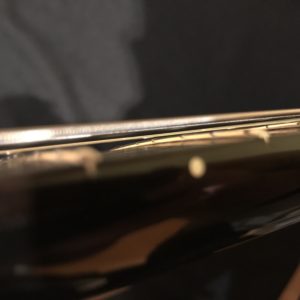
If relief is adjusted properly, you should see a gap of light roughly the same thickness of the third string itself when viewing the top of the seventh or eight fret. These points represent the middle of the pressed string between your fingers.
Too much relief means you need to tighten the truss rod to straighten the neck out - just like threading a nut on a bolt. A quarter turn or less, then check the relief again. Conversely, if there’s not enough relief, just adjust the truss rod in the other direction.
By tinkering with the combination of string height and neck relief, you should find an ideal “action” that’s suites your taste.
Final Touches
Once you have the action set to your liking, you can then give the strings their final stretches.
If there was one critically important factor in keeping your guitar in tune, I’d have to say it’s making sure your strings are fully stretched.
Give each string a good pull along it’s full length, each one in turn, then quickly bring them all up to pitch. Keep in mind the first couple of stretches will drop the pitches quite a bit, so save the real tuning precision for the last attempt or two. Playing the strings will also heat them up a bit and usually bring out a couple of tuning wobbles in the process. Totally normal, just keep at it.
By following these steps, you should now find you have a decent setup, and your strings have become pretty stable in short order. Now you have more time to play!
**Notes from the editor** This post was updated 07/01/2021. (Feature image and introduction changed.)
Steve Blundon has been a master guitar tech for over twenty five years. His extensive experience in the music industry has also included being a dedicated guitar teacher and music store owner serving generations of guitar enthusiasts. His site Guitarniche.com represents an ongoing effort to pass along those same years of knowledge so that guitar players have a first-hand resource to help keep their gear tip top.









